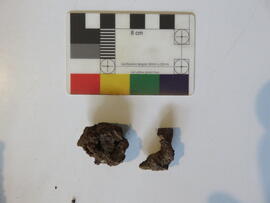Pipe stem.
Oyster shell.
Includes documentary archive relating to excavation, mainly site drawings. Includes site plans, sections of trenches, context locations and descriptions, context lists, finds list, trench descriptions.
Burnt residue on interiors
Iron nail and other
Bronze clasp, probably originally from a bible
Oyster shell
Struck flake, possibly Palaeolithic with later working to turn it into a scraper.
Iron lumps
Button with marquisites
Includes documentary archive relating to excavation, mainly site drawings. Includes site plans, sections of trenches, photographs, context locations and descriptions.
Three copper alloy pins
weight: 25g
Tr. 1: Lead stylus with one pointed and one flat end and used in a similar fashion to a pencil. Examples from Coppergate, York exist and are identical to Winchester Class 2 type styli and generally date from the 13th to 15th centuries (Ottaway & Rogers 2002, 2934). Length 104mm.
Tr. 2: Circular, flat lead disc with traces of two fixings; possibly a lid or similar. Diameter 24.8mm; undated.
K: Two refitting fragments from a cast-iron object with a central perforation. Heavily concreted and poorly preserved these weigh 227g with the perforation c. 13.6mm in diameter. Probably from an architectural feature, such as a fireplace, these are post- Medieval in origin.
T: Broken and very poorly preserved possible snaffle or bridle bit. The central bar is largely intact, but missing one end and associated loop (surviving length c. 120mm). The other loop is broken; weight 123g. Undated.
<151> : Several pieces of door furniture, including a large hinge-strap with leaf-shaped terminal c. 205mm long and weighing 196g; basal or top door pivot c. 94mm long, with right-angle staple arrangement weighing 60g; five nail fragments, the largest weighing 25g and with a dome-shaped head and square cross-sectioned shaft.
F.16: a mixed context. This contained a sherd of 13th to 15th century grey coarseware (21g), and a sherd of 16th to 17th century German stoneware (45g).
[095], F.33: a 16th century or 17th century context. This was dominated by glazed red earthenware (34 sherds, weighing 494g), and also contained a quantity of Frechen stoneware (22 sherds, weighing 574g); three fragments bearing embossed decoration – including portions of two coats of arms – were identified. Also present were five sherds of bichromatic red earthenware (30g), six sherds of Babylon-type lead-glazed earthenware (71g), two sherds of tin-glazed earthenware (4g) and six sherds of plain red coarseware (216g), plus two residual sherds of 15th to 16th century Seigburg stoneware (33g), and two sherds of 13th to 15th century grey coarseware (15g).
F.33: a 16th or 17th century context. This contained two sherds of Broad Street-type green-glazed fineware (230g), a sherd of Babylon-type lead-glazed earthenware (9g), a sherd of glazed red earthenware (14g) and two sherds of plain red coarseware (30g).








































